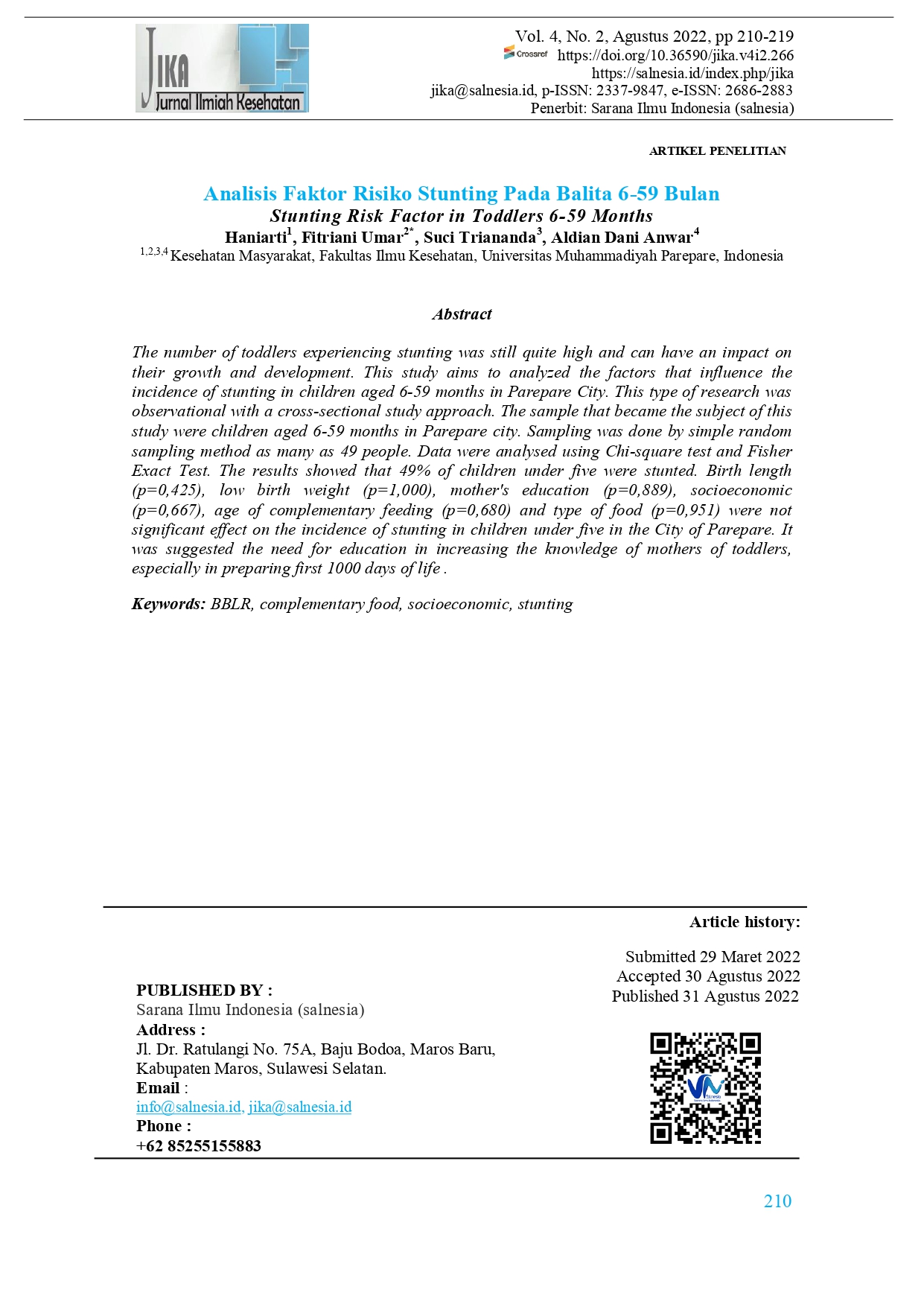Stunting Risk Factor in Toddlers 6-59 Months
DOI:
https://doi.org/10.36590/jika.v4i2.266Keywords:
BBLR, complementary food, socioeconomic, stuntingAbstract
The number of toddlers experiencing stunting was still quite high and can have an impact on their growth and development. This study aims to analyzed the factors that influence the incidence of stunting in children aged 6-59 months in Parepare City. This type of research was observational with a cross-sectional study approach. The sample that became the subject of this study were children aged 6-59 months in Parepare city. Sampling was done by simple random sampling method as many as 49 people. Data were analysed using Chi-square test and Fisher Exact Test. The results showed that 49% of children under five were stunted. Birth length (p=0,425), low birth weight (p=1,000), mother's education (p=0,889), socioeconomic (p=0,667), age of complementary feeding (p=0,680) and type of food (p=0,951) were not significant effect on the incidence of stunting in children under five in the City of Parepare. It was suggested the need for education in increasing the knowledge of mothers of toddlers, especially in preparing first 1000 days of life .
Downloads
References
Aryastami NK, Tarigan I. 2017. Kajian Kebijakan dan Penanggulangan Masalah Gizi Stunting di Indonesia. Buletin Penelitian Kesehatan, 45(4): 233–240.
Badan Penelitian dan Pengembangan Kesehatan. 2018. Laporan Hasil Riset Kesehatan Dasar (Riskesdas) Indonesia tahun 2018. Riset Kesehatan Dasar 2018.
Basri H, Hadju V, Zulkifli A, Syam A, Ansariadi, Stang, Indriasari R, Helmiyanti S. 2021. Dietary diversity, dietary patterns and dietary intake are associated with stunted children in Jeneponto District, Indonesia. Gaceta Sanitaria. SESPAS, 35: S483–S486. https://doi.org/10.1016/j.gaceta.2021.10.077.
Beal T, Tumilowicz A, Sutrisna A, Izwardy D, Neufeld LM. 2018. A review of child stunting determinants in Indonesia. Maternal and Child Nutrition, 14(4): 1–10. https://doi.org/10.1111/mcn.12617.
Bommer C, Vollmer S, Subramanian S V. 2019. How socioeconomic status moderates the stunting-age relationship in low-income and middle-income countries. BMJ Global Health, 4(1): 1–10. https://doi.org/10.1136/bmjgh-2018-001175.
Daming H, Hengky HK, Umar F. 2019. Faktor-Faktor Yang Mempengaruhi Kejadian Stunting Pada Balita Di Puskesmas Salo Kabupaten Pinrang. Jurnal Ilmiah Manusia dan Kesehatan, 2(1): 59–67.
de Onis M, Branca F. 2016. Childhood stunting: A global perspective. Maternal and Child Nutrition, 12: 12–26. https://doi.org/10.1111/mcn.12231.
Dinkes Parepare. 2019. Laporan Dinas Kesehatan Kota Parepare Tahun 2019. Dinkes Parepare
Domili I, Ruhmayanti NA, Tumenggung I, Misnati M, Hinelo SP. 2020. Analysis of energy and protein intake of stunting children in Ilotidea village, Tilango, Gorontalo. Enfermeria Clinica, 30(4): 227–230.
Gonete AT, Kassahun B, Mekonnen EG, Takele WW. 2021. Stunting at birth and associated factors among newborns delivered at the University of Gondar Comprehensive Specialized Referral Hospital. PLoS ONE, 16(1 January): 1–16. https://doi.org/10.1371/journal.pone.0245528.
Hana SA, Martha IK. 2012. Faktor Risiko Kejadian Stunting Pada Anak Usia 12-36 Bulan Di Kecamatan Pati, Kabupaten Pati. Journal of Nutrition College, 1(1): 30–37.
Hanindita M. 2020. Momyclopedia 78 Resep MP ASI. PT Gramedia PustakaUtama: Jakarta.
Hastuti, Hadju V, Citrakesumasari, Maddeppungeng M. 2020. Stunting prevalence and its relationship to birth length of 18–23 months old infants in Indonesia. Enfermeria Clinica. Elsevier España, S.L.U., 30: 205–209. https://doi.org/10.1016/j.enfcli.2019.10.069.
IDAI. 2018. Pemberian Makanan Pendamping Air Susu Ibu (MPASI). UKK Nutrisi dan Penyakit Metabolik IDAI, 18.
Kemenkes. 2018. Laporan Provinsi Sulawesi Selatan Riskesdas 2018. .
Kemenkes RI BP dan PK. 2013. Riset Kesehatan Dasar (RISKESDAS) 2013. Laporan Nasional Riskesdas 2013.
Lestari ED, Hasanah F, Nugroho NA. 2018. Correlation between non-exclusive breastfeeding and low birth weight to stunting in children. Paediatrica Indonesiana, 58(3): 123–7. https://doi.org/10.14238/pi58.3.2018.123-7.
Loya RRP, Nuryanto N. 2017. Pola Asuh Pemberian Makan Pada Balita Stunting Usia 6-12 Bulan di Kabupaten Sumba Tengah Nusa Tenggara Timur. Journal of Nutrition College, 6(1): 83–95.
Lukman TNE, Anwar F, Riyadi H, Harjomidjojo H, Martianto D. 2021. Birth Weight and Length Associated with Stunting among Children Under-Five in Indonesia. Jurnal Gizi Dan Pangan, 16(1): 99–108.
Millward DJ. 2017. Nutrition, infection and stunting: The roles of deficiencies of individual nutrients and foods, and of inflammation, as determinants of reduced linear growth of children. Nutrition Research Reviews, 30(1): 50–72. https://doi.org/10.1017/S0954422416000238.
Pristya TYR, Fitri AM, Wahyuningtyas W. 2021. Analysis of Relationship Between Socioeconomic and Sex with Stunting Among Children Under Five Years in Sangiangtanjung, Lebak Banten. Jurnal Kesehatan Komunitas, 6(3): 285–291. https://doi.org/10.25311/keskom.vol6.iss3.581.
Purwandari ES, Estiningtyas Sakilah Adnani Q, Yuli Astutik R. 2021. Analysis of Maternal Age At Married, Number of Children, History of Breastfeeding, Mother’S Education and High Risk of Pregnancy With Incidence of Stunting in Children Under Five-Years. Women, Midwives and Midwifery, 1(1): 21–30. https://doi.org/10.36749/wmm.1.1.21-30.2021.
Rafika M. 2019. Dampak Stunting Pada Kondisi Psikologis Anak. Buletin Jagaddhita, 1(1): 10–13.
Rusmil VK, Prahastuti TO, Erlangga Luftimas D, Hafsah T. 2019. Exclusive and Non-Exclusive Breastfeeding among Stunted and Normal 6–9 Month-Old-Children in Jatinangor Subdistrict, Indonesia. Althea Medical Journal, 6(1): 35–41. https://doi.org/10.15850/amj.v6n1.1598.
Saleh A, Syahrul S, Hadju V, Andriani I, Restika I. 2021. Role of Maternal in Preventing Stunting?: a Systematic Review. Gaceta Sanitaria, 35(2).
Setiawan E, Machmud R, Masrul M. 2018. Faktor-Faktor yang Berhubungan dengan Kejadian Stunting pada Anak Usia 24-59 Bulan di Wilayah Kerja Puskesmas Andalas Kecamatan Padang Timur Kota Padang Tahun 2018. Jurnal Kesehatan Andalas, 7(2): 275. https://doi.org/10.25077/jka.v7.i2.p275-284.2018.
Sutriana S, Usman U, Umar F. 2020. Analisis Faktor Resiko Kejadian Stunting Pada Balita Di Kawasan Pesisir Kabupaten Pinrang Risk Factor Analysis of The Incidence of Stunting in Children Under Five in the Coastal Area of Pinrang District. Jurnal Ilmiah Manusia dan Kesehatan, 3(3).
Titaley CR, Ariawan I, Hapsari D, Muasyaroh A, Dibley MJ. 2019. Determinants of the stunting of children under two years old in Indonesia: A multilevel analysis of the 2013 Indonesia basic health survey. Nutrients, 11(5). https://doi.org/10.3390/nu11051106.
Torlesse H, Cronin AA, Sebayang SK, Nandy R. 2016. Determinants of stunting in Indonesian children: Evidence from a cross-sectional survey indicate a prominent role for the water, sanitation and hygiene sector in stunting reduction. BMC Public Health. BMC Public Health, 16(1): 1–11. https://doi.org/10.1186/s12889-016-3339-8.
WHO [World Health Organization]. 2014. Global Nutrition Target 2025: Stuting Policy Brief. World Health Organization.

Downloads
Published
How to Cite
Issue
Section
License
Copyright (c) 2022 Fitriani Umar

This work is licensed under a Creative Commons Attribution 4.0 International License.








